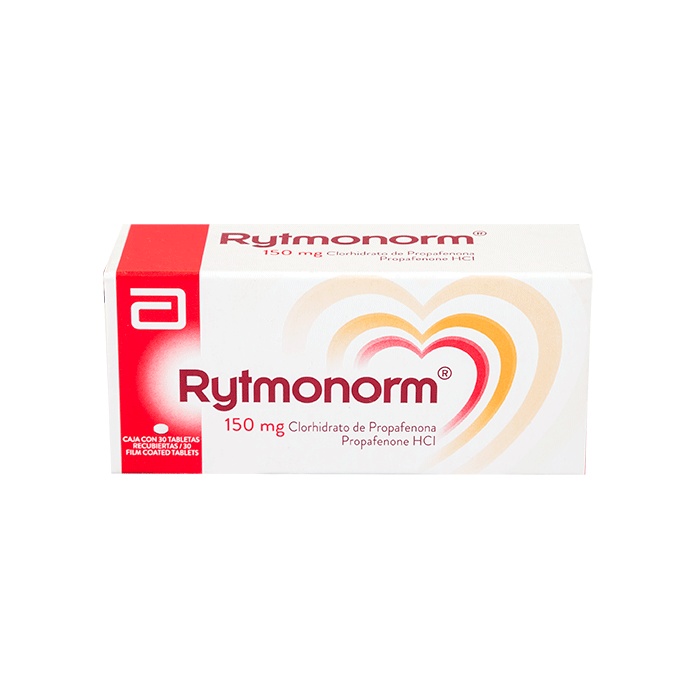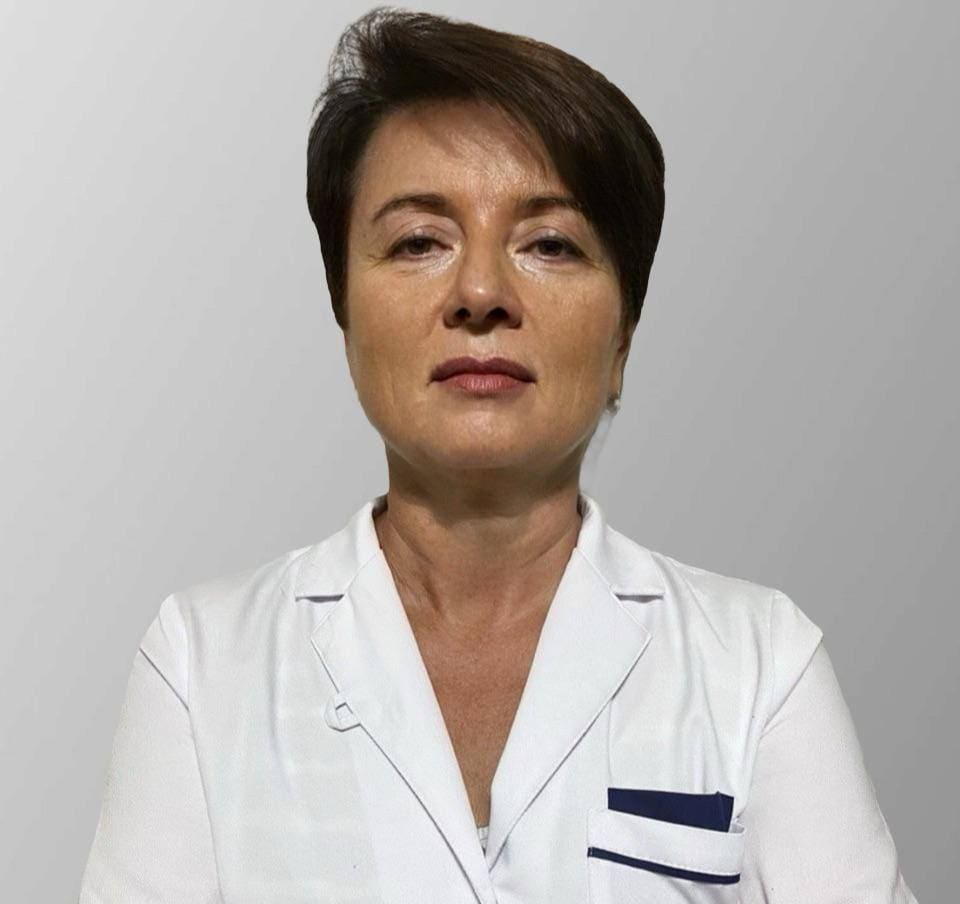

РИТМОНОРМ 150 мг ТАБЛЕТКИ, ПОКРИТІ ПЛІВКОВОЮ ОБОЛОНКОЮ

Запитайте лікаря про рецепт на РИТМОНОРМ 150 мг ТАБЛЕТКИ, ПОКРИТІ ПЛІВКОВОЮ ОБОЛОНКОЮ

Інструкція із застосування РИТМОНОРМ 150 мг ТАБЛЕТКИ, ПОКРИТІ ПЛІВКОВОЮ ОБОЛОНКОЮ
Вступ
Опис: інформація для користувача
Ритмонорм 150 мг покриті таблетки
Гідрохлорид пропафенону
Прочитайте уважно весь опис перед тим, як почнете приймати препарат, оскільки він містить важливу інформацію для вас.
- Збережіть цей опис, оскільки вам може знадобитися знову його прочитати.
- Якщо у вас виникли питання, проконсультуйтеся з вашим лікарем, фармацевтом або медсестрою.
- Цей препарат призначений тільки для вас і не слід давати його іншим людям, навіть якщо вони мають相同ні симптоми, оскільки це може їм нашкодити.
- Якщо ви відчуваєте побічні ефекти, проконсультуйтеся з вашим лікарем, фармацевтом або медсестрою, навіть якщо це побічні ефекти, які не вказані в цьому описі. Див. розділ 4.
Зміст опису:
- Що таке Ритмонорм і для чого він використовується
- Що потрібно знати перед тим, як почати приймати Ритмонорм
- Як приймати Ритмонорм
- Можливі побічні ефекти
- Зберігання Ритмонорму
- Зміст упаковки та додаткова інформація
1. Що таке Ритмонорм і для чого він використовується
Ритмонорм - це препарат, який використовується для лікування порушень ритму серця різного походження. Він належить до групи препаратів, званих антиаритмічними препаратами класу 1С за Воганом Вільямсом.
Ритмонорм використовується для лікування та профілактики пароксизмальної надшлуночкової тахікардії, яка включає атриальну фібриляцію та пароксизмальний фібриляційний тахікардія, а також для лікування та профілактики шлуночкових аритмій, які включають симптоматичні шлуночкові екстрасистоли та/або несумісну шлуночкову тахікардію.
2. Що потрібно знати перед тим, як почати приймати Ритмонорм
Не приймайте Ритмонорм
- Якщо ви алергічні на активну речовину або на будь-який інший компонент цього препарату (перелічені в розділі 6).
- Якщо у вас є анамнез синдрому Бругада (спадкова хвороба, характеризована аномалією на електрокардіограмі (ЕКГ) та підвищеним ризиком раптової смерті) (див. Попередження та обережність).
- Якщо ви мали інфаркт міокарда протягом 3 місяців перед початком лікування.
- Якщо у вас є значна хвороба серця, така як:
- серцева недостатність
- кардіогенний шок, якщо тільки причина не є аритмією
- гостра брадикардія
- якщо у вас є дисфункція синусового вузла, порушення провідності серця, атриовентрикулярний блок 2-го або вище ступеня або блокада гілки або дистальної блокади і у вас немає штучного кардіостимулятора
- якщо у вас є гостра гіпотонія.
- Якщо у вас є порушення електролітного балансу в крові (наприклад, порушення метаболізму калію).
- Якщо у вас є важка обструктивна хвороба легень.
- Якщо у вас є міастенія.
- Якщо ви приймаєте ритонавір (антіретровірусний препарат, який використовується для лікування інфекції ВІЛ, див. розділ "Прийом Ритмонорму з іншими препаратами").
Попередження та обережність
Проконсультуйтеся з вашим лікарем або фармацевтом перед тим, як почати приймати Ритмонорм:
- Це важливо, щоб кожен пацієнт, який приймає пропафенон, був клінічно оцінений та мав електрокардіограму перед та під час лікування Ритмонормом, щоб визначити, чи виправдане подальше лікування.
- Після лікування цим препаратом ваш лікар повинен виключити синдром Бругада, який міг бути присутнім без будь-яких попередніх симптомів.
- Якщо у вас є кардіостимулятор, оскільки лікування може вплинути на нього, тому потрібно контролювати та програмувати його знову, якщо це необхідно.
- Якщо у вас є атриальна фібриляція, оскільки Ритмонорм може призвести до появи більш важкої аритмії; див. розділ Можливі побічні ефекти.
- Якщо у вас є важка серцева хвороба, оскільки ви можете бути схильні до важких побічних ефектів і в цьому випадку лікування цим препаратом буде протипоказане.
- Якщо у вас є бронхіальна астма або інша хронічна обструктивна хвороба дихальної системи.
Діти
Студії взаємодії проводилися тільки у дорослих, тому невідомо, чи вони схожі у дітей.
Пацієнти похилого віку
У пацієнтів похилого віку Ритмонорм повинен використовуватися з великою обережністю.
Прийом Ритмонорму з іншими препаратами
Повідомте вашого лікаря або фармацевта, якщо ви приймаєте, нещодавно приймали або можете приймати будь-який інший препарат.
Можуть виникнути більш важкі побічні ефекти з Ритмонормом, якщо його приймати з місцевими анестетиками (наприклад, для імплантації кардіостимулятора, хірургічних чи стоматологічних процедур), а також з іншими препаратами, які мають інгібіторний ефект на серце, такими як бета-блокатори (для гіпертонії) або деякі антидепресанти.
Повідомте вашого лікаря, якщо ви приймаєте будь-який з наступних препаратів, оскільки вони можуть збільшити рівень Ритмонорму в крові:
- венлафаксин (для депресії)
- пропранолол (для гіпертонії та ангіни пекторіс)
- метопролол (для гіпертонії)
- дезіпрамін (для депресії)
- циклоспорин (для зниження імунітету)
- теофілін (для бронхіальної астми)
- дігоксин (для серцевих проблем)
Якщо виникнуть ознаки передозування, потрібно зменшити дозу цих препаратів згідно з інструкціями вашого лікаря.
Повідомте вашого лікаря, якщо ви приймаєте будь-який з наступних препаратів, оскільки вони можуть збільшити рівень гідрохлориду пропафенону в крові, тому може знадобитися контроль та корекція дози:
- кетоконазол (проти грибкових інфекцій)
- циметидин (для виразкової хвороби шлунку)
- хінідин (для аритмій серця або проти малярії)
- ерітроміцин (антібіотик)
- флуоксетин (для депресії)
- пароксетин (для депресії)
Також відбувається збільшення рівня гідрохлориду пропафенону при прийомі соку грейпфруту.
Комбінація Ритмонорму та аміодарону може призвести до порушення серцевої діяльності. Можливо, потрібно буде коригувати дозу обох препаратів.
Комбінація пропафенону та лідокаїну збільшує ризик побічних ефектів лідокаїну на центральну нервову систему.
Повідомте вашого лікаря, якщо ви приймаєте будь-який з наступних препаратів, оскільки вони можуть зменшити ефективність Ритмонорму:
- ріфампіцин (антібіотик)
- фенобарбітал (снодійний та антиепілептичний препарат)
- фенітойн (антієпілептичний препарат)
- карбамазепін
У разі тривалого лікування цими препаратами та Ритмонормом потрібно контролювати реакцію на лікування Ритмонормом.
Повідомте вашого лікаря, якщо ви приймаєте препарати для профілактики згортання крові (наприклад, аценокумарол або варфарин), оскільки Ритмонорм може збільшити ефективність цих препаратів, підвищуючи ризик кровотечі. Можливо, потрібно буде зменшити дозу антикоагулянту.
Прийом Ритмонорму з харчами та напоями
Через гіркий смак та поверхневий анестезуючий ефект гідрохлориду пропафенону таблетки Ритмонорму повинні прийматися без жування чи розжовування, разом з деякою кількістю рідини.
Вагітність, лактація та фертильність
Якщо ви вагітні або перебуваєте в період лактації, вважаєте, що можете бути вагітною або плануєте вагітність, проконсультуйтеся з вашим лікарем або фармацевтом перед тим, як приймати цей препарат.
Немає достатніх та добре контрольованих досліджень у вагітних жінок. Ритмонорм не повинен використовуватися під час вагітності, якщо тільки очікувана користь не виправдовує потенційний ризик для плода. Гідрохлорид пропафенону проникає через плацентарний бар'єр.
Не вивчено виділення гідрохлориду пропафенону в грудне молоко. Обмежені дані свідчать про те, що гідрохлорид пропафенону може виділятися в грудне молоко, тому потрібно використовувати його з обережністю у жінок під час лактації.
Водіння транспортних засобів та робота з машинами
Під час лікування можуть виникнути розмитість зору, головокружіння, втома або зниження артеріального тиску, тому якщо ви відчуваєте ці симптоми, не повинні водити транспортні засоби чи працювати з небезпечними машинами.
Ритмонорм містить натрій
Цей препарат містить менше 23 мг натрію (1 ммоль) на покриту таблетку; це означає, що він практично не містить натрію.
3. Як приймати Ритмонорм
Слідуйте точно інструкціям щодо прийому цього препарату, вказаним вашим лікарем або фармацевтом. У разі сумнівів проконсультуйтеся з вашим лікарем або фармацевтом.
Ритмонорм приймається перорально.
Дорослі
Ваш лікар визначить індивідуальну підтримуючу дозу шляхом контролю серцевої діяльності, тобто за допомогою кількох електрокардіограм та вимірювання артеріального тиску (фаза调整). Для фази调整 та підтримуючого лікування рекомендується добова доза 450-600 мг, розділена на 2-3 прийоми на добу (1 таблетка Ритмонорму 150 мг 3 рази на добу або 1 таблетка Ритмонорму 300 мг 2 рази на добу) у пацієнтів, які важать близько 70 кг.
Іноді може знадобитися збільшення добової дози до 900 мг (2 таблетки Ритмонорму 150 мг 3 рази на добу).
Для пацієнтів, які важать менше 70 кг, добова доза повинна бути зменшена відповідно, починаючи з 150 мг 2 рази на добу. Збільшення дози не повинно проводитися до тих пір, поки пацієнт не пройде лікування протягом 3-4 днів.
Якщо ви пацієнт похилого віку або маєте пошкодження серця, Ритмонорм 150 мг, як і інші антиаритмічні препарати, буде призначено у фазі调整 з великою обережністю, починаючи з дози 150 мг 1 раз на добу та поступово збільшуючи дозу. Підтримуюча доза для кожної особи повинна бути розрахована з урахуванням контролю серцевої діяльності та повторних вимірювань артеріального тиску (фаза调整). Будь-яке збільшення дози, яке потрібно, не повинно проводитися до тих пір, поки пацієнт не пройде лікування протягом 5-8 днів.
Те саме стосується підтримуючого лікування. Будь-яке збільшення дози, яке потрібно, не повинно проводитися до тих пір, поки пацієнт не пройде лікування протягом 5-8 днів.
Пошкодження печінки та/або нирок
Якщо у вас є пошкодження печінки або нирок, ваш лікар почне лікування з дози 150 мг 1 раз на добу та буде коригувати дозу відповідно до вашої реакції на лікування.
Використання у дітей та підлітків
У дітей середня добова доза становить 10-20 мг гідрохлориду пропафенону на кілограм ваги тіла, розділена на 3-4 прийоми на добу у фазі调整 та підтримуючому лікуванні.
Збільшення дози не повинно проводитися до тих пір, поки пацієнт не пройде лікування протягом 3-4 днів.
Підтримуюча доза повинна бути розрахована для кожної особи з урахуванням контролю серцевої діяльності та повторних вимірювань артеріального тиску (фаза调整).
Ваш лікар призначить тривалість лікування. Не припиняйте лікування раніше, оскільки хоча ви вже можете відчувати себе краще, ваша хвороба може погіршитися або знову виникнути.
Пам'ятайте про прийом препарату. Прийоміть таблетки о同じ час кожного дня.
Якщо ви вважаєте, що дія Ритмонорму надто сильна або слабка, повідомте про це вашому лікареві або фармацевту.
Якщо ви прийняли більше Ритмонорму, ніж потрібно
Якщо ви прийняли більшу дозу, ніж призначена, негайно зверніться до вашого лікаря, щоб отримати медичну допомогу. Можуть виникнути важкі симптоми. Якщо ви прийняли більше Ритмонорму, ніж потрібно, ви можете відчувати серцеві ефекти та зниження артеріального тиску, яке в важких випадках може призвести до кардіогенічного шоку. Часто виникають головний біль, головокружіння, розмитість зору, оніміння або поколювання шкіри, тремор, нудота, запор та сухість у роті.
У важких випадках інтоксикації спостерігаються конвульсії, оніміння або поколювання шкіри, сонливість, кома та зупинка дихання. Були випадки смерті.
Якщо це трапилося, пацієнта потрібно спостерігати в інтенсивній терапії.
Якщо ви прийняли більше Ритмонорму, ніж потрібно, негайно зверніться до вашого лікаря або фармацевта або телефонуйте до служби токсикологічної інформації, телефон 91.562.04.20, вказуючи препарат та кількість, прийняту.
Якщо ви забули прийняти Ритмонорм
Не приймайте подвійну дозу для компенсації пропущених доз.
У разі забуття прийому препарату приймайте його якнайшвидше, продовжуючи лікування згідно з призначенням. Однак, якщо наступна доза вже близька, краще не приймати пропущену дозу та чекати наступної.
Якщо ви припинили лікування Ритмонормом
Якщо у вас є інші питання щодо використання цього препарату, проконсультуйтеся з вашим лікарем, фармацевтом або медсестрою.
4. Можливі побічні ефекти
Як і всі лікарські засоби, цей лікарський засіб може викликати побічні ефекти, хоча не всі люди їх відчувають.
Побічні ефекти класифікуються на дуже часті (можуть впливати на більше 1 з 10 осіб), часті (можуть впливати до 1 з 10 осіб), рідкісні (можуть впливати до 1 з 100 осіб) та частота невідома (не може бути оцінена на основі доступних даних).
Дуже часті побічні ефекти, пов'язані з лікуванням пропафеноном, - це головокружіння, порушення провідності серця (порушення в серці) та серцебиття.
У кожній групі побічні ефекти представлені в порядку зменшення тяжкості, від найбільшої до найменшої, коли могла бути визначена тяжкість для пацієнта.
Було повідомлено про наступні побічні ефекти:
Порушення крові та лімфатичної системи:
- Рідкісні: зниження кількості тромбоцитів (клітин крові, які беруть участь у згортанні).
- Частота невідома: зниження кількості лейкоцитів (клітин крові, які діють захищаючи організм від інфекцій або чужорідних речовин, може проявлятися у вигляді частих інфекцій з гарячкою, ознобом або больовими відчуттями в горлі), зниження кількості гранулоцитів (типу лейкоцитів, який може підвищувати схильність до інфекцій), сильне зниження кількості гранулоцитів або нейтрофілів (агранулоцитоз, захворювання, при якому людина стає більш схильною до інфекцій).
Порушення імунної системи:
- Частота невідома: гіперчутливість.
Гіперчутливість може проявлятися у вигляді холестазу (зупинки потоку жовчі до дванадцятипалої кишки), порушень крові та висипань на шкірі.
Порушення метаболізму та харчування:
- Рідкісні: зниження апетиту.
Психічні розлади:
- Часті: тривога, порушення сну.
- Рідкісні: кошмари.
- Частота невідома: стан плутанини.
Порушення нервової системи:
- Дуже часті: головокружіння.
- Часті: головний біль, порушення смаку.
- Рідкісні: короткочасна втрата свідомості (синкоп), порушення координації, відчуття оніміння, поколювання або печіння в будь-якій частині тіла, але частіше в ногах, руках, ліктях або ногах (парестезія).
- Частота невідома: судоми, екстрапірамідні симптоми (неконтрольовані рухи), неспокій.
Головокружіння - виключно вертиго.
Очні порушення:
- Часті: розмитість зору.
Порушення вуха та лабіринту:
- Рідкісні: вертиго.
Серцево-судинні порушення:
- Дуже часті: порушення серцевої провідності, серцебиття.
- Часті: синусова брадикардія (сповільнення серцебиття), зниження частоти серцевих скорочень, тахікардія (пришвидшення серцебиття), атриальний фібриляційний ритм (анормальний серцевий ритм, який відбувається в передсердях).
- Рідкісні: ventrikuläre тахікардія (пришвидшення серцебиття, яке починається в шлуночках і має понад 100 скорочень на хвилину), аритмія (порушення частоти серцебиття, яке може збільшуватися, зменшуватися або ставати нерегулярним).
- Частота невідома: фібриляція шлуночків, серцевої недостатності, зниження частоти серцебиття.
Порушення серцевої провідності включають синоатріальний блок, атриовентрикулярний блок та інтравентрикулярний блок.
Пропафенон може бути пов'язаний з проаритмічними ефектами, які проявляються у вигляді збільшення частоти серцебиття (тахікардії) або фібриляції шлуночків. Деякі з цих аритмій можуть загрожувати життю та потребувати реанімаційних заходів для попередження потенційно смертельного результату.
Серцевої недостатності може погіршуватися при наявності попередньої серцевої недостатності.
Судинні порушення:
- Рідкісні: гіпотонія (зниження артеріального тиску).
- Частота невідома: гіпотонія при тривалому стоянні та/або при піднятті (ортостатична гіпотонія).
Дихальні, грудні та медіастинальні порушення:
- Часті: задихання (брак повітря або труднощі з диханням).
Гастроінтестинальні порушення:
- Часті: біль у животі, блювота, нудота, діарея, запор, сухість у роті.
- Рідкісні: розширення живота (розтягнення черевної порожнини), метеоризм (гази).
- Частота невідома: рвота, порушення шлунково-кишкового тракту.
Печінково-жовчеві порушення:
- Часті: порушення функції печінки.
- Частота невідома: ушкодження печінки, обструкція жовчних шляхів (холестаз), гепатит, жовтяниця (жовтізація шкіри та очей).
Додаткові дослідження:
- Часті: порушення функції печінки, виявлені під час аналізу крові, такі як збільшення аспартатамінотрансферази, аланінамінотрансферази, гамма-глутамілтрансферази та алкальної фосфатази крові.
Порушення шкіри та підшкірної клітковини:
- Рідкісні: кропив'янка, свербіж, висипання на шкірі, еритема (червоність шкіри).
М'язово-скелетні та сполучні тканини:
- Частота невідома: синдром, подібний до системного червоного вовчака (автоімунне захворювання).
Порушення репродуктивної системи та молочних залоз:
- Рідкісні: імпотенція (еректильна дисфункція).
- Частота невідома: зниження кількості сперми.
Зниження кількості сперми є оборотнім після припинення прийому пропафенону.
Загальні порушення та зміни в місці застосування:
- Часті: біль у грудній клітці, астенія (чуття втоми), втома, гарячка.
Повідомлення про побічні ефекти
Якщо ви відчуваєте будь-які побічні ефекти, зверніться до свого лікаря, фармацевта або медсестри, навіть якщо це можливі побічні ефекти, які не вказані в цій інструкції. Ви також можете повідомити про них безпосередньо через систему моніторингу лікарських засобів для людини: https://www.notificaram.es. Надсилаючи повідомлення про побічні ефекти, ви можете допомогти надати більше інформації про безпеку цього лікарського засобу.
5. Зберігання Ритмонорма
Тримайте цей лікарський засіб поза зоною видимості та досягнення дітей.
Цьому лікарському засобу не потрібні спеціальні умови зберігання.
Не використовуйте цей лікарський засіб після закінчення терміну придатності, вказаного на упаковці після CAD. Термін придатності - останній день місяця, який вказано.
Лікарські засоби не повинні викидатися у водопровідні труби чи сміття. Відкладайте упаковки та лікарські засоби, які вам не потрібні, у спеціальному пункті збору фармацевтичного сміття. Спитайте у свого фармацевта, як позбутися упаковок та лікарських засобів, які вам вже не потрібні. Таким чином ви допоможете захистити навколишнє середовище.
6. Зміст упаковки та додаткова інформація
Склад Ритмонорма
Активний інгредієнт - гідрохлорид пропафенону. Кожна таблетка містить 150 мг гідрохлориду пропафенону.
Інші компоненти (експіцієнти) - мікрокристалічна целюлоза, кроскармелоза натрію, стеарат магнію, кукурудзяний крохмаль, гідроксипропілметилцелюлоза, макрогол 400, макрогол 6000, діоксид титану (E 171) та очищена вода.
Вигляд продукту та вміст упаковки
Ритмонорм 150 мг покриті таблетки - круглі білі таблетки з написом "150" на одній стороні.
Кожна упаковка містить 60 покритих таблеток.
Власник дозволу на маркетинг та відповідальна особа за виробництво
Власник:
Teva B.V.,
Swensweg 5,
2031GA Haarlem,
Нідерланди
Відповідальна особа за виробництво:
ITC Production s.r.l.
Via Pontina km 29
00071 Pomezia (RM)
Італія
Для отримання додаткової інформації щодо цього лікарського засобу зверніться до місцевого представника власника дозволу на маркетинг:
Teva Pharma, S.L.U.
C/ Anabel Segura, 11, Edificio Albatros B, 1ª planta
Alcobendas 28108 Madrid
Іспанія
Дата останнього перегляду цієї інструкції: Березень 2019
Детальна інформація про цей лікарський засіб доступна на сайті Іспанського агентства лікарських засобів та медичних продуктів (AEMPS) http://www.aemps.gob.es/
- - - - - - - - - - - - - - - - - - - - - - - - - - - - - - - - - - - - - - - - - - - - - - - - - - - - - - - - - - - - - - - - - - - - -
Ця інформація призначена лише для медичних працівників:
Лікування передозування
Окрім загальних заходів екстреної допомоги необхідний моніторинг та корекція життєво важливих показників пацієнта (за необхідності) в інтенсивній терапії.
Дефібриляція, а також інфузія допаміну та ізопреналіну були ефективними у контролі ритму та артеріального тиску. Судоми були полегшені внутрішньовенним введенням дазепану. Можуть бути необхідні загальні підтримувальні заходи, такі як механічна вентиляція легень та зовнішній масаж серця.
Спроби видалення шляхом гемофільтрації є неефективними.
Гемодіаліз не має жодного ефекту через велику зв'язку пропафенону з білками (> 95%) та величезний об'єм розподілу.
Інші форми випуску
Ритмонорм 300 мг покриті таблетки. Упаковки по 60 покритих таблеток.
Ритмонорм 3,5 мг/мл розчин для ін'єкцій. Упаковки по 5 ампул по 20 мл.

Скільки коштує РИТМОНОРМ 150 мг ТАБЛЕТКИ, ПОКРИТІ ПЛІВКОВОЮ ОБОЛОНКОЮ в Іспанії у 2025 році?
РИТМОНОРМ 150 мг ТАБЛЕТКИ, ПОКРИТІ ПЛІВКОВОЮ ОБОЛОНКОЮ коштує в середньому 4.39 євро у листопад, 2025 році. Ціна може змінюватися залежно від регіону, аптеки та наявності рецепта. Рекомендуємо перевіряти актуальну вартість у місцевих аптеках або через онлайн-сервіси.
- Країна реєстрації
- Середня ціна в аптеках4.39 EUR
- Діючі речовини
- Потрібен рецептТак
- Виробник
- Інформація є довідковою і не є медичною порадою. Перед прийомом будь-яких препаратів обов'язково проконсультуйтеся з лікарем. Oladoctor не несе відповідальності за медичні рішення, прийняті на основі цього контенту.
- Альтернативи до РИТМОНОРМ 150 мг ТАБЛЕТКИ, ПОКРИТІ ПЛІВКОВОЮ ОБОЛОНКОЮФорма випуску: РОЗЧИН ДЛЯ ІН'ЄКЦІЙ, 70 мг пропафенону гідрохлориду / 20 млДіючі речовини: propafenoneВиробник: Teva B.V.Потрібен рецептФорма випуску: ТАБЛЕТКА, 300 мг пропафенону гідрохлоридуДіючі речовини: propafenoneВиробник: Teva B.V.Потрібен рецептФорма випуску: РОЗЧИН ДЛЯ ІН'ЄКЦІЙ, 10 мг ацетату флекаїніду/млДіючі речовини: flecainideВиробник: Viatris Healthcare LimitedПотрібен рецепт
Аналоги РИТМОНОРМ 150 мг ТАБЛЕТКИ, ПОКРИТІ ПЛІВКОВОЮ ОБОЛОНКОЮ в інших країнах
Найкращі аналоги з тією самою діючою речовиною та терапевтичним ефектом.
Аналог РИТМОНОРМ 150 мг ТАБЛЕТКИ, ПОКРИТІ ПЛІВКОВОЮ ОБОЛОНКОЮ у Польща
Аналог РИТМОНОРМ 150 мг ТАБЛЕТКИ, ПОКРИТІ ПЛІВКОВОЮ ОБОЛОНКОЮ у Україна
Лікарі онлайн щодо РИТМОНОРМ 150 мг ТАБЛЕТКИ, ПОКРИТІ ПЛІВКОВОЮ ОБОЛОНКОЮ
Консультація щодо дозування, побічних ефектів, взаємодій, протипоказань та поновлення рецепта на РИТМОНОРМ 150 мг ТАБЛЕТКИ, ПОКРИТІ ПЛІВКОВОЮ ОБОЛОНКОЮ – за рішенням лікаря та згідно з місцевими правилами.









